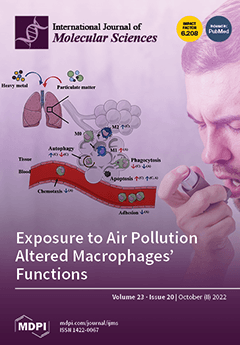Ischemic cardiomyopathy leads to inflammation and left ventricular (LV) dysfunction. Animal studies provided evidence for cardioprotective effects of the endocannabinoid system, including cardiomyocyte adaptation, inflammation, and remodeling. Cannabinoid type-2 receptor (CB2) deficiency led to increased apoptosis and infarctions with worsened LV function in
[...] Read more.
Ischemic cardiomyopathy leads to inflammation and left ventricular (LV) dysfunction. Animal studies provided evidence for cardioprotective effects of the endocannabinoid system, including cardiomyocyte adaptation, inflammation, and remodeling. Cannabinoid type-2 receptor (CB2) deficiency led to increased apoptosis and infarctions with worsened LV function in ischemic cardiomyopathy. The aim of our study was to investigate a possible cardioprotective effect of endocannabinoid anandamide (AEA) after ischemia and reperfusion (I/R). Therefore, fatty acid amide hydrolase deficient (FAAH)
−/− mice were subjected to repetitive, daily, 15 min, left anterior descending artery (LAD) occlusion over 3 and 7 consecutive days. Interestingly, FAAH
−/− mice showed stigmata such as enhanced inflammation, cardiomyocyte loss, stronger remodeling, and persistent scar with deteriorated LV function compared to wild-type (WT) littermates. As endocannabinoids also activate PPAR-α (peroxisome proliferator-activated receptor), PPAR-α mediated effects of AEA were eliminated with PPAR-α antagonist GW6471 i.v. in FAAH
−/− mice. LV function was assessed using M-mode echocardiography. Immunohistochemical analysis revealed apoptosis, macrophage accumulation, collagen deposition, and remodeling. Hypertrophy was determined by cardiomyocyte area and heart weight/tibia length. Molecular analyses involved Taqman
® RT-qPCR and immune cells were analyzed with fluorescence-activated cell sorting (FACS). Most importantly, collagen deposition was reduced to WT levels when FAAH
−/− mice were treated with GW6471. Chemokine ligand-2 (CCL2) expression was significantly higher in FAAH
−/− mice compared to WT, followed by higher macrophage infiltration in infarcted areas, both being reversed by GW6471 treatment. Besides restoring antioxidative properties and contractile elements, PPAR-α antagonism also reversed hypertrophy and remodeling in FAAH
−/− mice. Finally, FAAH
−/−-mice showed more substantial downregulation of PPAR-α compared to WT, suggesting a compensatory mechanism as endocannabinoids are also ligands for PPAR-α, and its activation causes lipotoxicity leading to cardiomyocyte apoptosis. Our study gives novel insights into the role of endocannabinoids acting via PPAR-α. We hypothesize that the increase in endocannabinoids may have partially detrimental effects on cardiomyocyte survival due to PPAR-α activation.
Full article






